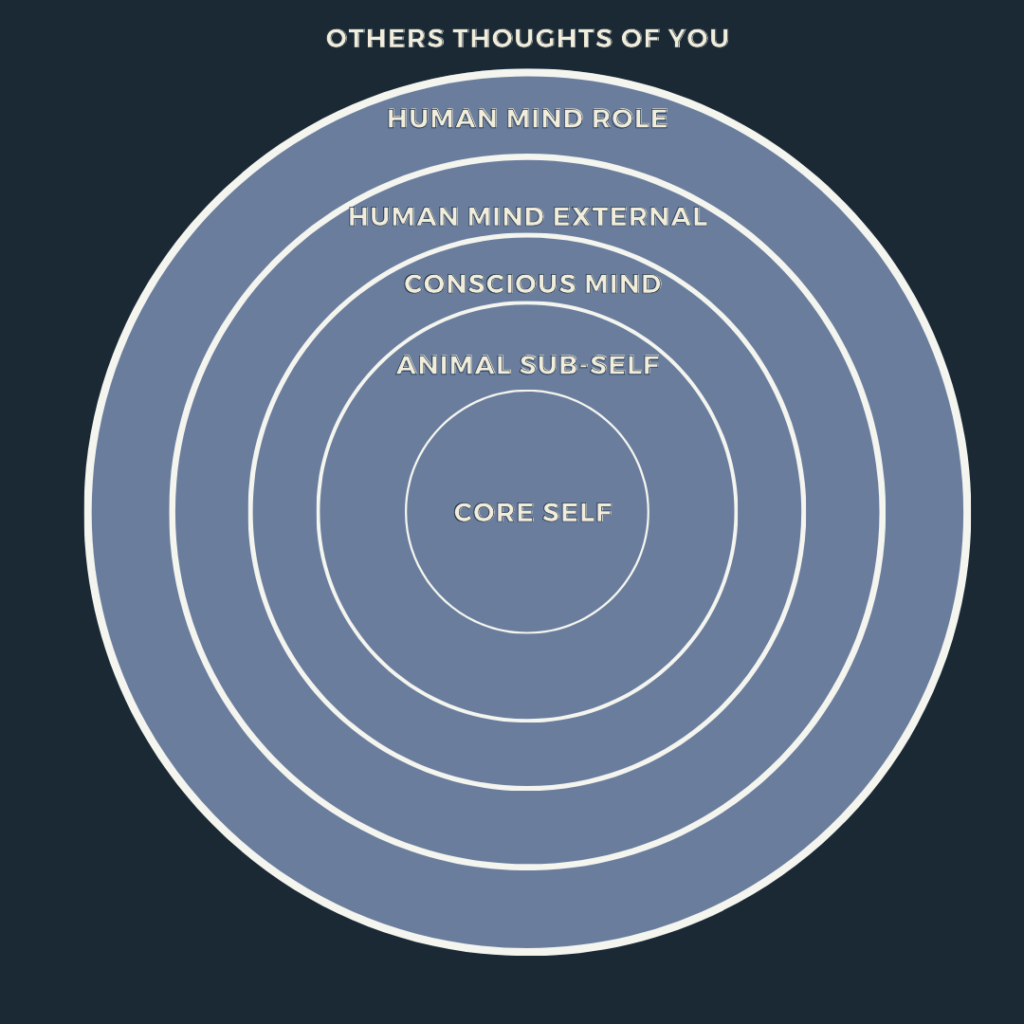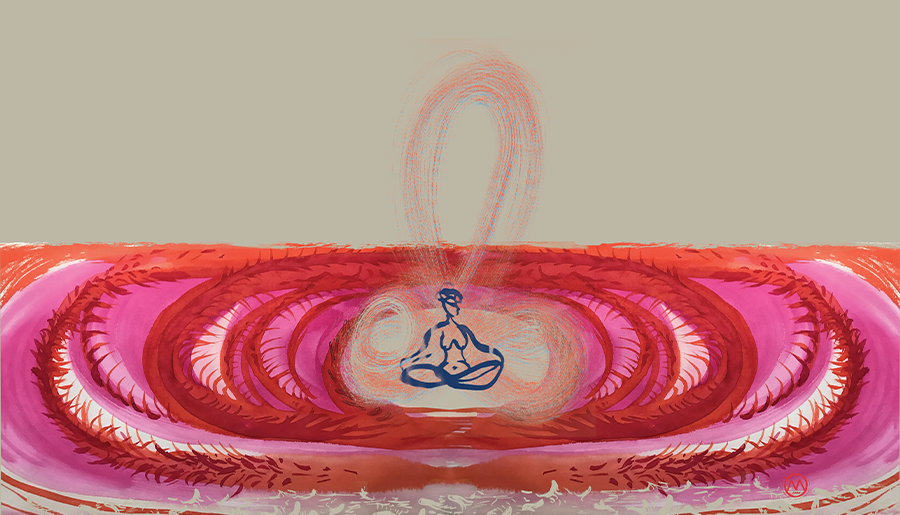Have you ever wondered how your mind is built? According to Robert Monroe, an American parapsychologist, and author of books on leaving the body, the human mind consists of several layers.
In this article you will learn:
- How the mind is built: the core of the self, the animal sub-selves, the conscious mind, the external human mind, the role of the human mind, and the thoughts of others about you.
- What is meditation, what its purpose is, and why it is worth meditating.
- You will learn the types of meditation: guided, concentration, movement, mantras, visualization, and mindfulness.
The first is others’ thoughts of you
They are forces of psychic energy created by what others think of you. A part of the collective mind. These are the famous Gombrowicz’s mugs. Social masks, are forms that are imposed on you by society, and that you adopt when you come into contact with other people.
“You’re always late!”
“You must be an artist!”
“You eat like a pig!”
“You’re a mess!”

Their source is determinism:
- genetic, which, for example, explains your impulsiveness with your grandfather’s genes,
- psychological, which believes that the causes of your character lie in your upbringing and childhood experiences,
- environmental, which believes that the environment is responsible for what you are, e.g. material situation, state policy, or backyard buddies.
we are not independent, we are only a function of other people, we must be as they see us […]there is no escape from the mug, other than into another mug
Witold Gombrowicz
.
The next layer is the human mind’s role
The outermost level of what you want others to think about you. A facade without feeling or intuition. A mask that you put on when you go out into the outside world. The role you play in front of others.
The third layer is the human mind’s external
Your facade, what you think, and want others to think about you. This layer is constantly changing with new experiences and perceptions.
The next layer is the conscious mind.
This is the level at which you are aware of who you think you are. It is your identification with this world. Accumulation of all your beliefs. Who you think you are.
The fifth layer is the animal sub-self.
It is your identification with your specific physical incarnation and the struggles that are associated with your physical-animal body. Mammalian brain and limbic system.
The last, middle layer is the core self.
It is your spirit, the essence of the sum of all your experiences from all your lifetimes.
To get to the very center of you, you have to get rid of all these layers. How to do it? This is what meditation is for.
As you already know, your brain is not a muscle, but it can and must be trained. You can consciously influence its work by controlling your brain waves or you can influence its structure by modeling the connections between neurons. But did you know you can also train him to limit your thoughts? Meditation comes to your aid here.
Meditation what is it?
If you are wondering about it because you have never tried and you are a little scared. This is nothing but mind training. Something like a gym for your body.
Meditation is an exercise in which you consciously put your brain into a theta brainwave state. Training that allows you to turn off your thinking and silence your ego. When used as a spiritual practice, it is consciously acting to bring you into this state.
In other words, the state when you turn off your thinking so that your brain can take a break from it for a moment.
This kind of suspension, doing nothing, mindlessly “staring at the ceiling,” as your sister calls it, is meditation. You’ve been doing it intuitively since childhood, which irritated her a lot. You loved watching your thoughts. You also did it often when, for example, you were cold or were in pain to switch off these feelings, but you didn’t turn it into a conscious, everyday habit until a few years ago.
Meditation practice can take place while sitting or lying down, but it can also be part of some physical activity. Mindfulness accompanies you in your daily activities. Meditation does not have to be related to any religious practice. It is simply a state of peace of mind in which you observe the thoughts appearing in your head without engaging your attention in any of them. Thoughts just pop up in your head and flow and go.
There are many styles of meditation and activities that are considered meditation practices.
The purpose of meditation is enlightenment. Although nowadays this practice is used to relax, and fight stress, depression, and other life problems related to the ego. It is about calming your thoughts and putting you in a state where you will be pure awareness, i.e. your own soul. When you turn your attention inward and clear your mind of thoughts and ideas, you will then be able to feel your own essence. You will become a witness watching yourself. You will realize who you are at the very core of your being. Consequently, it will lead you to enlightenment.
Meditation teaches you to shift your attention from the physical plane to the broader perspective of being one.
Why is it worth meditating?
Of course, besides enlightenment, there are other reasons as well. The life of each of us is associated with functioning in an awakened world. Our mind is constantly flooded with information that causes stress. Which leads to depression, panic attacks, anxiety, and various crises. Just 10 minutes of meditation a day reduces stress levels, improves the clarity of thoughts, and relieves anxiety. It also improves the self-awareness of one’s own body.
There are many different types of meditation. They come from different religions or cultures. Zen, Hinduism, Buddhism, Sufism, Taoism, and even Christianity all have their own meditation methods. It is only up to you which one you choose. You just have to try and choose which one suits you best. In general, we distinguish several basic meditation techniques:
Guided meditation
It is listening to someone’s voice that guides you. You can practice it with a teacher or by listening to it yourself, e.g. on YouTube, or using some application. Most often it is accompanied by instrumental music or sounds. An example of this is traditional meditation, scanning – it consists in observing the experiences and feelings flowing from your body without becoming attached to them or judging them, e.g. yoga Nidra or binaural beats.
Concentration
It is about focusing your attention on some object or your breath. These include vipassana, the creation and subsequent destruction of mandalas used in Tibetan Buddhism, pranayama, and even adoration of the Blessed Sacrament.
Movement meditation
It is based on the observation of the feelings in your body during movement, whether during a walk, while practicing yoga, or dancing, e.g. natural dance or 5 rhythms dance.
Mantra meditation
Consisting of repeating or chanting a phrase, sound, or syllable (mantra) in the mind. Such an example is, for example, the recitation of the rosary in Catholicism, transcendental meditation.
Visualization meditations
Consisting of directing the mind towards certain images.
Mindfulness Meditations
Rather than focusing your attention on an object, you open yourself to all aspects of the experience, both internal and external, but not responding to them. For example mindfulness
How to start?
Just try it. Find a place where you will have some peace for yourself and where you know that no one will disturb you. Get in a comfortable position, that’s it. Start with a few minutes, even 3 to 5 minutes. It’s important to do this every day. When you get used to it, you can gradually increase the time, even up to several hours. It all depends on you.
Source:
Giovanni Dienstmann „Types of Meditation – An Overview of 23 Meditation Techniques”, liveanddare.com, https://liveanddare.com/types-of-meditation/
Robert A. Monroe „Ultimate Journey”, Broadway Books, New York, 2000.
Thanks to our collaboration with Mindvalley, you can now try meditation by learning from world experts.

From work, career, sex, love, and health — The M Word takes meditation to a whole new level by upgrading an ancient practice into a remarkable tool to upgrade your life. Learn the meditation practice of the world’s top performers with one of the world’s leading experts in meditation, Emily Fletcher.

